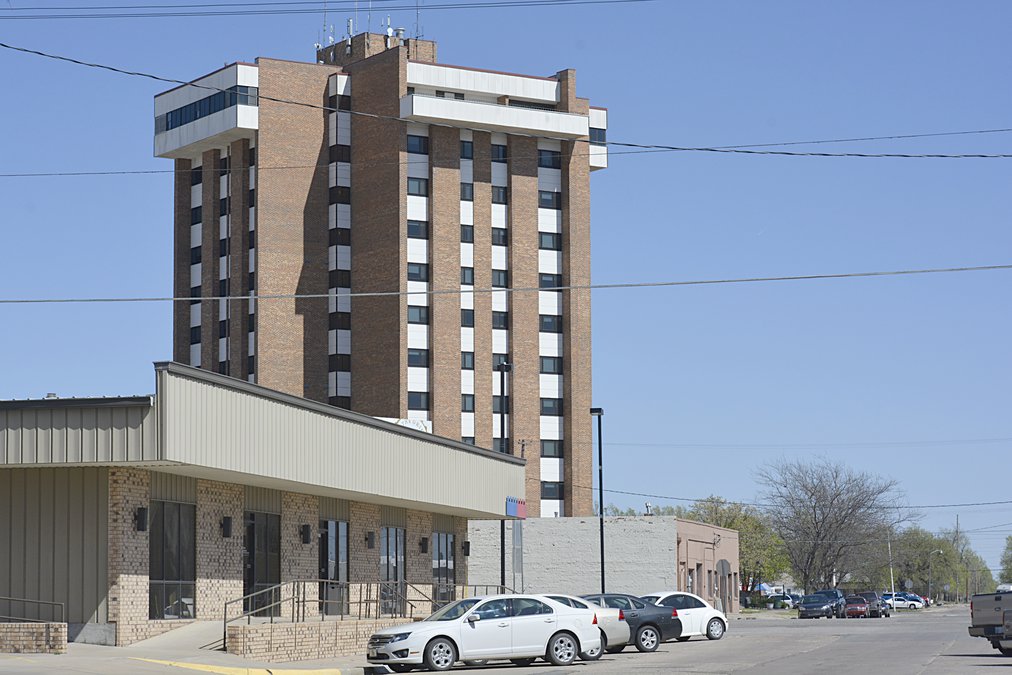On Saturday morning, Nov. 16, the Kansas Historic Sites Board of Review will meet at the Kansas Museum of History classrooms in Topeka to review nominations of 14 Kansas properties to be added to the National Park Service’s National Register for Historic Places, as it does quarterly. Among them is the 48-page long application for Great Bend’s 12-story High Rise apartment building at 1101 Kansas Ave, owned by the City of Great Bend Housing Authority.
The proposal includes a detailed history of Great Bend, with a focus on housing availability and demographics of the area in the 1960’s. The city was at peak population, and there was a shortage of affordable housing for senior citizens.
The application lists it as an example of Brutalist-style architecture. According to architectural reporter Jessica Stewart, writing for MyModernMet.com, Brutalism began in the mid-20th century, reaching its peak in the mid 1970’s, and was used primarily for institutional buildings.
According to data contained within the application, it was conceived as a solution to the problem following the passage of the Housing and Urban Development Act of 1965. More than one developer was eager to take on a project for low-income housing that would be funded by the federal government, despite reluctance even amongst Great Bend City Council members who were reluctant due to the perception it could attract a bad element to town. Ultimately, the decision to create senior housing allowed the project to gain steam.
A ground-breaking ceremony was held on site on Nov. 23, 1970, and the project was completed on Jan. 8, 1972. It cost roughly $1.8 million to build, according to the information contained within the application. A ribbon cutting and open house was held on Aug. 27, 1972, to showcase the new state-of-the-art building.
“Over 3,000 visitors attended, and 55 apartments were rented out to local seniors. Rents for the units ranged from $10-$60 based on income. At the time of the open house, more than 35 apartments were rented, with paperwork being completed on 20 more. Most of the tenants were single elderly women, though there were also some elderly men. Eligible tenants were 62 years of age or older. In the case of couples, at least one of the pairs had to be 62. Income could not exceed $3,500 for single residents and $4,000 for couples. Applications were to be filled out in person in the presence of a housing official due to the length and complexity of the documentation required.”
Sometime in 1973, an activities coordinator was hired by the GBHA. That person planned exercise classes, luncheons, and entertainment. It became a popular place to live, according to GBHA meeting minutes, and a waiting list for occupancy was consistent throughout the 1970’s and 1980’s.
Today, High Rise is an income-based apartment building funded by the U.S. Dept. of Housing and Urban Development. Renters pay 30 percent of the household income and utilities are provided at no cost.
According to guidelines for listing a property on the National Register of Historic Places at NPS.gov, after the nomination is reviewed by the KHSBR, certifying recommendations and the nomination itself will be submitted to the National Park Service in Washington D.C. where it will undergo additional review. A determination is usually made public within 45 days. If High Rise is approved for inclusion in the NHRHP, it will become eligible for preservation incentives including federal grants, federal and possibly state incentive tax credits, preservation easements, and international building code (IBC) fire and life safety code alternatives.
The meeting will begin at 9 a.m. and can be followed on Twitter @kansashistory. Read the draft nomination here.





